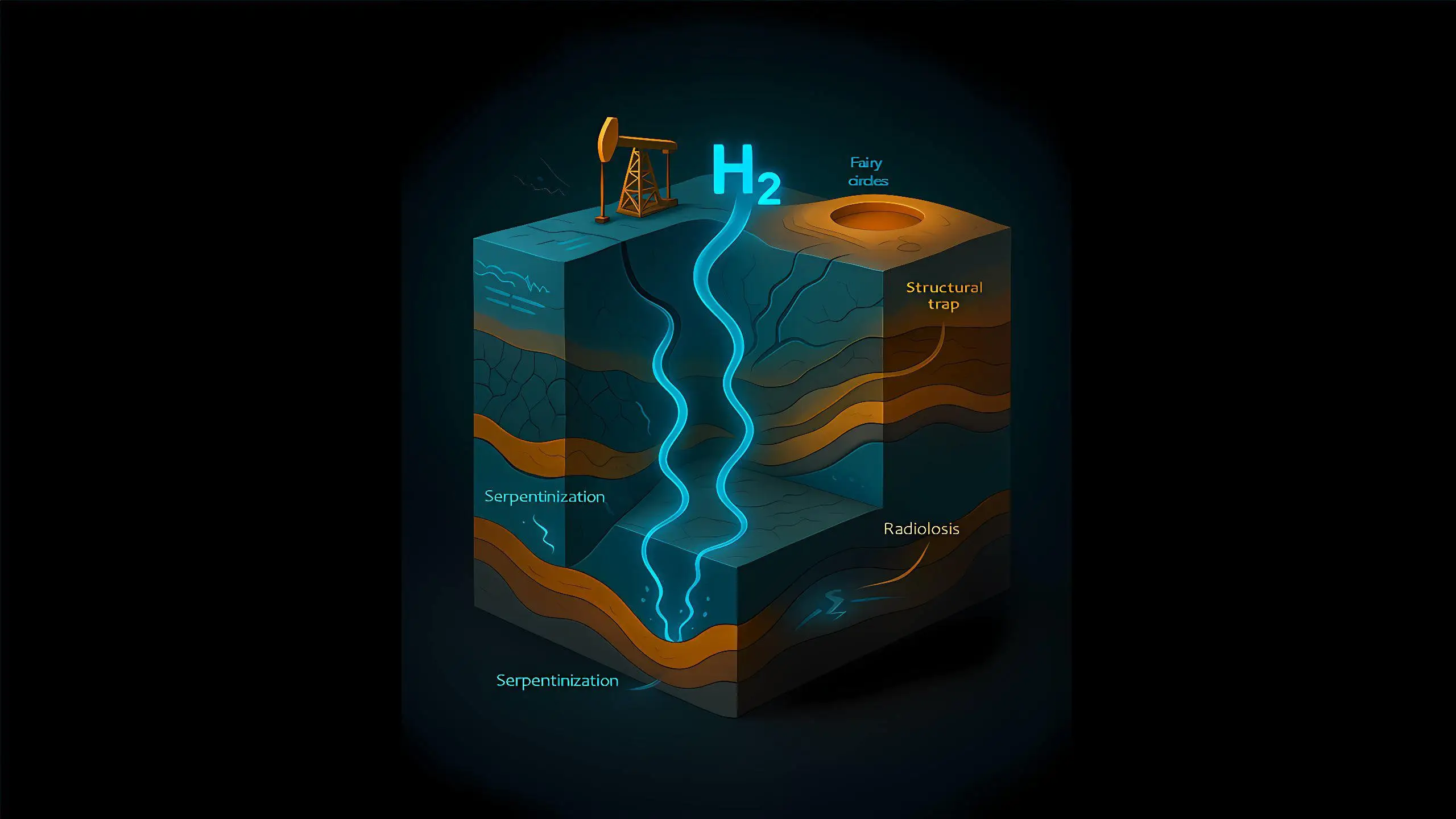Natural hydrogen (H₂) has emerged as a low‑carbon energy resource with high potential in the energy transition, and it also plays a key role in subsurface microbial ecosystems dependent on chemolithotrophic processes. Its generation underground—particularly in crystalline environments—occurs primarily through water‑rock interactions, such as serpentinization of ultramafic rocks, and radiolysis, which splits water molecules due to the natural decay of radioactive elements (U, Th, K) present in the lithosphere. The latter process, in addition to producing H₂, can generate sulfate, which acts as an electron acceptor in hydrogen‑dependent sulfate‑reducing microbial metabolisms (Higgins et al., 2025). Since these mechanisms occur naturally, H₂ can be considered a renewable resource.
This type of hydrogen has been detected in various geological settings, including ophiolites, intracratonic basins, extensional zones, and other rock types. Notable examples include the Bourakebougou field in Mali, where a hydrogen‑rich accumulation is already being exploited; the São Francisco Basin in Brazil, which shows high concentrations in wells and numerous surface emissions; and ophiolite‑associated seepages, such as the iconic “eternal flame” of Chimaera in Turkey. Active exploration is also underway in regions of Australia and in the foothills of the western Pyrenees (France and Spain). In Spain, there is additionally a natural hydrogen deposit in Huesca—specifically in Monzón—which is currently under study and expected to be exploited in the future.
Natural hydrogen exploration follows a progression similar to oil exploration. The first step is detecting signs of hydrogen presence and linking them to a generating source. This preliminary analysis allows estimating the resource’s potential volume, guiding further characterization and exploitation efforts. Next, it’s necessary to understand the gas’s migration mechanisms toward possible traps or reservoirs, and finally characterize these reservoirs to assess their viability.
Geophysics, using seismic and potential methods, plays a key role in this initial phase, as it enables delineation of the subsurface geological structures, setting the physical framework of the system. Meanwhile, geochemistry is essential for detecting surface emanations and tracking H₂ migration, which often appears at the surface as circular depressions. Moreover, detailed rock analysis—such as studying chromitites in ophiolites using three-dimensional techniques like microtomography—provides better insight into gas generation, storage, and circulation processes.
In this complex framework, the integrating geologist has the mission of reconstructing a region’s geological history, identifying the events and conditions that enabled hydrogen generation, migration, and retention underground, as well as locating potential reservoirs.
Once the first exploratory well is drilled, a more detailed evaluation is conducted using petrophysical and rock-physics techniques, which allow more precise reservoir characterization and the definition of detection criteria based on seismic attributes. This information is then integrated into a geocellular model, enabling simulation of the complete system and guiding future exploitation decisions.
Highlighted Cases in Latin America
Brazil – Petrobras: The national oil company launched in 2024 an R&D program for natural hydrogen with an initial investment of 20 million reais. As early as 2023, it organized specialized workshops and international collaborations to evaluate natural H₂ prospecting tools (inspenet.com). This joint effort (between Petrobras engineers and research centers) aims to validate geophysical and geochemical methodologies and map potential generators in Brazilian basins .
Chile: A team led by Dr. Diana Comte (Univ. Chile) obtained national funding to study natural hydrogen in the Andean Altiplano. Their interdisciplinary research integrates geology, geochemistry, and geophysics to define a conceptual model of H₂ formation and accumulation in northern Chile (uchile.cl). Techniques planned include surface gas sampling, isotopic measurements, and geothermal modeling to identify emission hotspots. This academic study demonstrates adoption of an integrated approach similar to that used in oil exploration but adapted for hydrogen.
Highlighted Cases in Europe
Spain – Monzón Project (Helio Aragón): In Aragón, Helio Aragón (a BP and Spanish Axión joint venture) is leading the first European natural hydrogen project. According to pv‑magazine, the Monzón prospect was defined using 2D seismic and high‑density gravity surveys, and extensive surface geochemical sampling detected elevated H₂ (and He) concentrations above the reservoir and main faults. Drilling of the Monzón‑2 well is scheduled for the second half of 2024 (~€12 M), which will be the first well in Europe aimed at extracting natural hydrogen. The company reports that the Monzón structure (anticlines and traps) and geochemical anomalies suggest recoverable volumes estimated at over 1 million tonnes of H₂ in the current permit, with greater potential in the region. Development considers conventional continuous production technologies with projected costs below €1/kg (without need for electrolysis or new storage) .
France – Sauve Terre Permit and TBH2: In December 2023, France authorized the first research permit dedicated to native hydrogen in the Pyrénées-Atlantiques (called “Sauve Terre H₂”). Granted to the startup TBH2 Aquitaine (a company spun off from deeptech Terrensis), it covers 225 km² of Béarn. The area was selected for meeting “all necessary conditions” for H₂ generation and accumulation (usinenouvelle.com): the mantle rock is relatively shallow, allowing meteoric waters to penetrate serpentinitized peridotites (generating hydrogen through Fe oxidation), and the structure includes anticline folds with impermeable materials (Keuper clay layers) that would act as natural seals. The press highlights that these geological elements (meteoric aquifers, nearby ophiolites, structural traps) configure a very favorable integrated system. This pioneering French permit reflects how areas with surface evidence of H₂ and suitable geology are prioritized.
These examples illustrate the potential of technological integration in exploration. For instance, detecting chimneys and pockmarks in seismic data, combined with surface geochemical anomalies, directly indicates the existence of deep sources of interest (stet-review.org & pv-magazine.es).
Constructing 3D models, fed with field and geophysical data (such as seismic, gravimetry, and magnetometry), allows for high-resolution definition of reservoir geometry and evaluation of seal integrity. In turn, data obtained from wells will help refine and update reservoir characteristics with greater precision.
Thus, combining advanced seismic, intelligent sensors, laboratory analysis, and artificial intelligence significantly reduces exploration uncertainty. Each anomaly can be validated through the integration of multiple sources of evidence—structural, geochemical, and modeled—which increases confidence in results and improves decision-making in natural hydrogen exploration.
Although the field of natural hydrogen is still in its early stages, its enormous energy potential is already evident. Its development will require overcoming technical challenges, such as material degradation due to hydrogen exposure and risks of seal failures in wells, as well as a deeper understanding of its behavior in the subsurface. However, the emergence of new companies and the growth of scientific research around this resource demonstrate a growing confidence in its viability.
The experience and infrastructure of the oil and gas sector can be crucial to accelerate this development, providing tools, knowledge, and methodologies that have already been tested. Interdisciplinary collaboration will be necessary to advance the technology and knowledge required for its efficient and safe large-scale exploitation.
Explorations in different regions of the world suggest that there could be reserves capable of meeting global demand for thousands of years, making natural hydrogen a strategic resource of great relevance for the energy transition.
In summary, the exploration of natural hydrogen is both a scientific and technical challenge and a unique opportunity. It opens new frontiers for geosciences, expanding the scope of geoscientists and positioning them as key players in the development of an emerging industry with the potential to transform the planet’s energy future.

